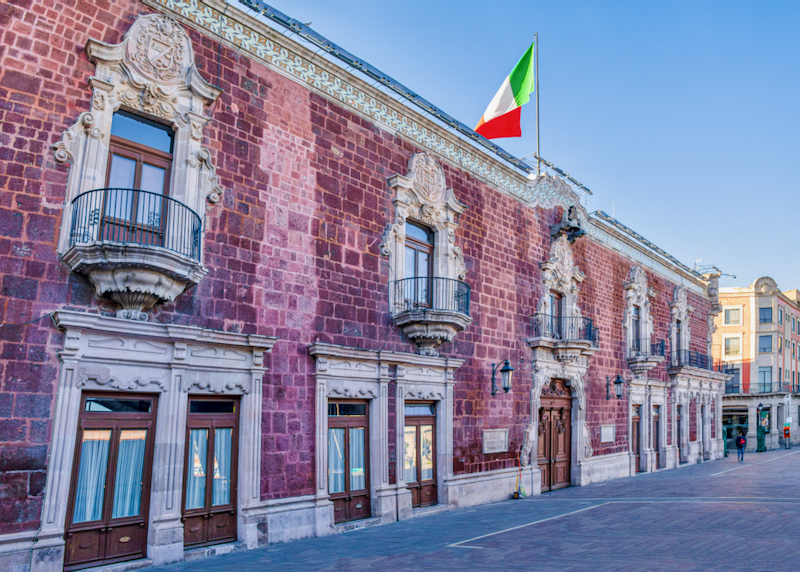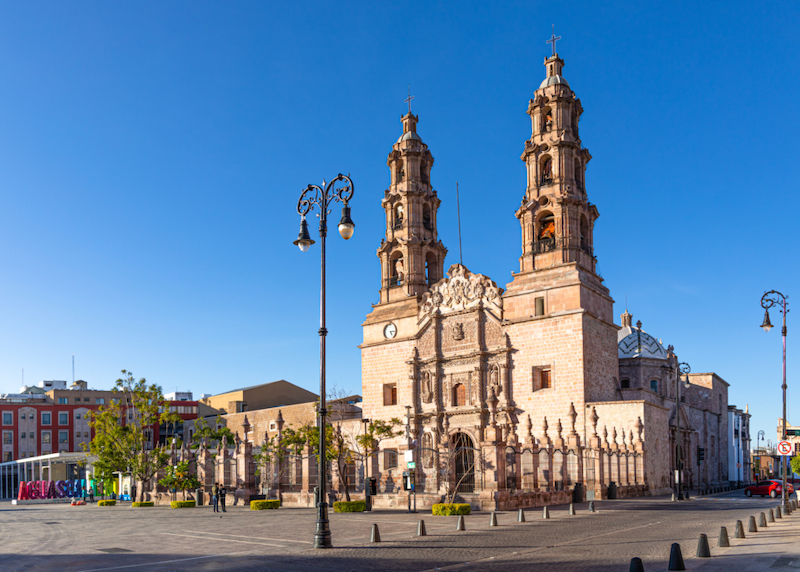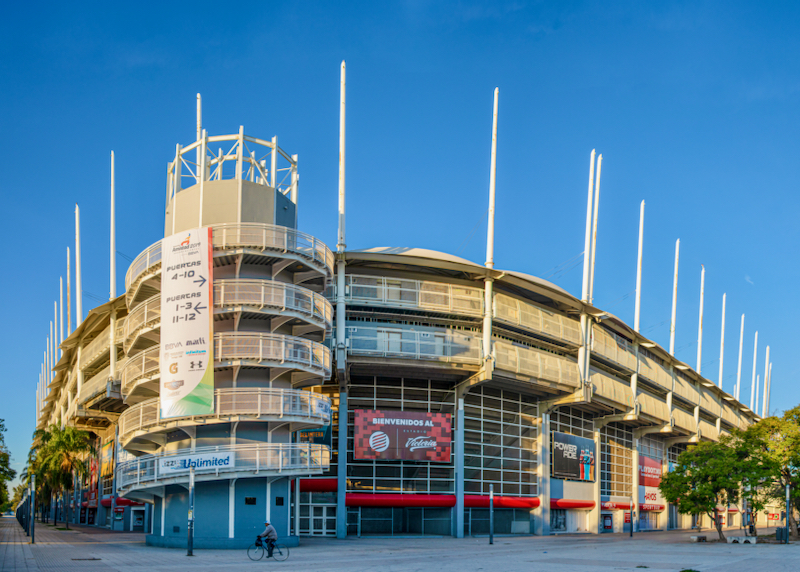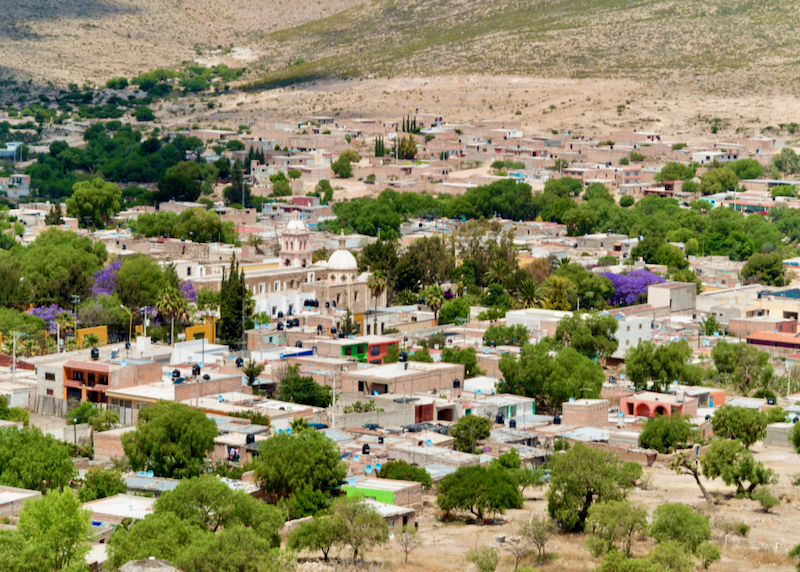Mexico › Aguascalientes
Updated: February 28, 2022
See Also
- Mexico – Where to Go
- Mexico – With Kids
- Mexico – Best Time to Visit
- Mexico – Best Beaches
- Mexico – Cancun vs Tulum vs Playa del Carmen
Aguascalientes is one of Mexico’s most dynamic modern cities, with a booming economy and a rich artistic history. We love its pristine colonial center, absorbing museums and its tasty street food.

The Government Palace of the State of Aguascalientes.
Frequently Asked Questions about Aguascalientes
Where is Aguascalientes?
Aguascalientes is the capital of the state of Aguascalientes, in the region of central Mexico known as the Bajío. Aguascalientes lies about 490 km northwest of Mexico City, 220 km northeast of Guadalajara, and 165 km west of San Luis Potosí. Non-stop flights to Aguascalientes take less than 4 hours from Chicago, 3 hours from Los Angeles, 2 hours from Dallas or Houston, and 1.5 hours from Mexico City.
How big is Aguascalientes?
Aguascalientes has a greater metro population of just under 1 million. The main city covers some 385 square kilometers.
What is the history of Aguascalientes?
Once the home of the Chichimeca people, Aguascalientes was officially founded in 1575 by Spanish captain Juan de Montoro Rodríguez, though it was little more than a pit-stop between Mexico City and the silver mines further north. Development remained sluggish and the city only started to grow in the 19th century, when several nearby villages merged together. The state of Aguascalientes was formally created in 1857 (before that the city had been tied to Zacatecas), and the 1914 Convention of Aguascalientes saw revolutionary leaders Francisco Villa, Emiliano Zapata and Venustiano Carranza meet for the first time. In the last fifty years Aguascalientes has morphed into one of Mexico’s richest cities, home to two large Nissan manufacturing plants, as well as hubs for Texas Instruments and Coca-Cola.
How do I get to Aguascalientes?
Aguascalientes is connected to the US by convenient non-stop flights from Chicago, Los Angeles, Dallas, and Houston, and frequent shuttles from Mexico City. Flights from Canada and Europe usually route through Mexico City or the US. The airport is 16 km south of the city; taxis charge around 300 pesos into the center (prices are fixed according to a zone system). With luggage, this is the best option.
Within Mexico, first-class long-distance buses are an economical and comfortable alternative to flying – buses to Aguascalientes from Guadalajara (3 hours) and Mexico City (6 hours) operate hourly. Aguascalientes’s Central de Autobuses (bus station) is just 2 km south of the center on Avenida de la Convención. There is a frequent bus service (9.50 pesos) from here to Plaza de la Patria (“Centro”), at the heart of town. With luggage it’s best to take a taxi to the hotel – these should use the meter, with fares unlikely to be more than 50 pesos.

Catedral Basilica De Nuestra Senora De La Asuncion, in the Plaza de la Patria.
Can I use Uber in Aguascalientes?
Uber does operate in Aguascalientes (assuming phones have roaming, and the app works), but drivers are usually reluctant to pick-up from the airport due to hostility from the airport taxi union. However, Uber can be used to return to the airport for as low as 145 pesos. Once in the city, getting an Uber should be no problem, and can be cheaper than regular taxis.
Can I drive to Aguascalientes?
Driving down from the US border to Aguascalientes is relatively straightforward; the main highways are good, and virtually empty outside the towns. However, the Mexican border states of Nuevo León, Sonora, and Tamaulipas have been affected by drug cartel violence – driving at night is definitely a bad idea. Check the latest travel advisories at travel.state.gov or ask at the hotel. Cars also need a Mexican “Temporary Importation of Vehicle Permit”.
From Laredo, Texas the drive is around 490 miles (790 km) and takes around 9 hours non-stop. Aguascalientes is 830 miles (1335 km) from El Paso, Texas (16 hours), and 1430 miles (2300 km) from San Diego, California.
If renting a vehicle, it’s much easier to do this once across the Mexican border, as taking US rental vehicles into Mexico comes with all sorts of restrictions.
Do I need a car in Aguascalientes?
Most of the city center of Aguascalientes can be explored on foot making a car unnecessary. However, Ubers or local taxis (the meter starts at 13.50 pesos and most trips should be under 50 pesos) are available for those who prefer not to walk. Local buses charge a flat fare of 13.50 pesos but are unlikely to be needed.

Estadio Victoria football stadium, home to the Mexican football team Necaxa.
When is the best time to go to Aguascalientes?
Aguascalientes boasts a year-round temperate climate, with the driest and sunniest months November to April. Rain is most common June to September. There’s no real “bad” time to visit, though it can actually get chilly December to January. March through May is probably best, when the weather is pleasantly warm, the days dry, and crowds low-key.
Where should I stay in Aguascalientes?
The best place to stay is right in the historic heart of Aguascalientes (the centro histórico), close to all the sights, best restaurants, and attractions. Motel chains have sprung up around the city, near the major highways, and can offer good rates, but these are all a long way from the action and it can be a hassle getting in and out of the center. Note that during the Feria de San Marcos mid-April to mid-May, rooms are usually booked solid and cost over 50 percent extra. We like the Francia, an updated but atmospheric hotel from 1915, and the magnificent Quinta Real, which was designed to look like a Spanish monastery. The best budget option is the El Giro Hostal (Allende 341).
What are the best things to do in Aguascalientes?
The best thing to do in Aguascalientes is to soak up the city’s colonial charm and history, and take in some of its excellent art museums. Start by sipping coffee at an outdoor café and taking in the scene on Aguascalientes’s main square, the Plaza de la Patria, also the location of the city’s impressive 18th-century cathedral, the Teatro Morelos (location of the famous convention between Zapata, Villa and Carranza in 1914), and the mural-smothered Palacio de Gobierno.
The Museo José Guadalupe Posada (Trujillo 222) is one of the highlights of Aguascalientes, dedicated to the macabre lithographs of the eponymous artist (Posada was famous for using skulls in his illustrations). The bold naturalistic work of local artist Saturnino Herrán is the focus at the Museo de Aguascalientes (Zaragoza 505), while the Museo de Arte Contemporáneo No. 8 (Primo Verdad, at Morelos) showcases contemporary art from the region, as well as the work of local painter Enrique Guzmán. It’s also worth checking out the Museo Nacional de la Muerte (Jardín del Estudiante, Rivero y Gutiérrez), dedicated to Mexico’s death rituals and folk images of death, including ornately decorated skulls (calaveras). The Museo Regional de Historia (Carranza 118) chronicles local history.
Be sure also to visit the Santuario Nuestra Señora de Guadalupe (Guadalupe Nájera 213), one of the most stunning churches in Mexico, as well as the Templo del Señor del Encino (Jardín del Encino), another gorgeous 18th-century church built from pink sandstone.

The town of Real de Asientos, a ‘Pueblo Magico‘ or magic town, a title given to particularly beautiful romantic towns in Mexico.
What are the best things to do around Aguascalientes?
Aguascalientes makes a good base to explore the surrounding area. Highlights include the hot spring baths that give the city its name (literally “hot waters”), the Baños Termales de Ojocaliente, some 4 km east of the center (take a taxi or “Ruta 12” bus along López Mateos).
What are the restaurants in Aguascalientes like?
The restaurants in Aguascalientes are excellent. The city is known for bírria (slow-roasted barbecued lamb, shredded and served with a bowl of piquant broth), best experienced at Mercado Juárez (aka Mercado de la Bírria), at Victoria and Unión, crammed with cheap food stalls. Other specialties include lechón al horno (roast suckling pig), served at no-frills joints such as Lechón Pascualito (Jesús Díaz de León 101), atole (a sweet corn- and chocolate-based drink), and addictive desserts made with guava (guayaba). Our other favorites in Aguascalientes include Cenaduría Farolito (Moctezuma 105), an old-fashioned café open since 1922 right on the plaza; Durería El Rey del Duro (Matamoros Nte 207) which knocks out tacos and crispy pork rinds (chicharrón or “duro” in Aguascalientes); Mitla Restaurante (Madero 222), another old-fashioned Mexican buffet restaurant operating since 1938; and La Saturnina (Carranza 110), a lovely courtyard café.
What currency is used in Aguascalientes?
The Mexican peso (often pre-fixed with a “$” sign) is the currency of Mexico. Most major shops and restaurants in Aguascalientes accept credit cards, but it is a good idea to have some peso cash on hand for museum entry and small purchases like bottled water and snacks. ATMs and banks are easy to find in central Aguascalientes (a couple of banks with 24hr ATMs are on the north side of Plaza de la Patria) – a better rate of exchange can be found at ATMs than at casas de cambio.
Is Aguascalientes expensive?
It’s easy to visit Aguascalientes on a modest budget. To save cash, stay in the cheaper B&Bs or hostels (budget Airbnb deals are also a viable option), and eat at local restaurants and taco stalls. Buses and taxis are cheap, and museum entry is rarely more than US$2–3.
Is Aguascalientes safe?
Aguascalientes has generally avoided the drug violence that has affected other parts of Mexico. Take the usual precautions, especially at night, and keep valuables in room safes.
Read More
- Cancun – Best Hotels
- Cancun – Family Hotels
- Isla Mujeres – Best Hotels
- Isla Mujeres – Family Hotels
- Los Cabos – Travel Guide
- Los Cabos – Best Hotels
- Los Cabos – Family Hotels
- Mazatlan – Best Hotels
- Mazatlan – Family Hotels
- Playa del Carmen – Best Hotels
- Playa del Carmen – Family Hotels
- Puerto Vallarta – Best Hotels
- Puerto Vallarta – Family Hotels
- Punta de Mita – Best Hotels
- Sayulita – Best Hotels
- Tulum – Best Hotels
- Tulum – Family Hotels